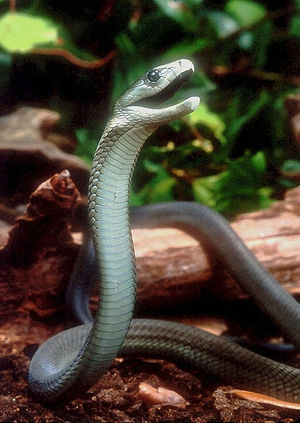CZ:Featured article/Current: Difference between revisions
imported>Chunbum Park No edit summary |
imported>John Stephenson (update) |
||
| Line 1: | Line 1: | ||
== '''[[ | == '''[[Black mamba]]''' == | ||
---- | ----{{Image|Dendroaspis polylepis.jpg|right|300px|A black mamba.}} | ||
The '''Black mamba''' (''Dendroaspis polylepis''), also commonly known as the '''common black mamba''' or the '''black-mouthed mamba'''<ref name= 'ct'>[http://www.toxinology.com/fusebox.cfm?fuseaction=main.snakes.display&id=SN0170 Dendroaspis polylepis] at [http://www.toxinology.com/ Clinical Toxinology Resource]. Accessed 6 May 2012.</ref> is a species of large, highly venomous snake belonging to the Elapidae family and is native to [[Africa]]. The black mamba is the longest venomous snake species in Africa, measuring between 2.5 and 3.2 m (8.2 and 10 ft) in length on average, and capable of growing to lengths of {{convert|4.45|m|ft}}.<ref name='Marais'>Marais, Johan. 2004. ''A Complete Guide to the Snakes of Southern Africa''. Cape Town, South Africa: Struik Nature. 95-97 pp. ISBN 1-86872-932-X.</ref> This species is named for the black colouration inside the mouth rather than the colour of its scales which varies from dull yellowish-green to a gun-metal grey. It is the fastest snake in the world, capable of moving at 4.32 to 5.4 metres per second (16–20 km/h, 10–12 mph).<ref name= 'NGS'>[http://animals.nationalgeographic.com/animals/reptiles/black-mamba/ Black mamba] at [http://www.nationalgeographic.com/ National Geographic Society]. Accessed 6 May 2012.</ref> Black mambas are fast, nervous, lethally venomous, and when threatened, highly aggressive. They have been blamed for numerous human deaths, and African myths exaggerate their capabilities to legendary proportions. For these reasons, the black mamba is widely considered to be the world’s deadliest snake.<ref name= 'NGS'/><ref name='myths'>Smith, Roddy. [http://www.wildlife-pictures-online.com/black-mamba.html Black mamba myths and Other snake stories] at ''Wildlife Conservation - Lower Zambezi National Park, Zambia''. The Witness. Accessed 6 May 2012.</ref> Before the advent of black mamba antivenom, a bite from this species was 100% fatal, usually within about 20 minutes in very severe cases of envenomation.<ref name= 'NGS'/><ref name= 'PBS'>Lee, Donald. [http://www.thirteen.org/pressroom/pdf/nature/season28/Nature28BlackMambarelease.pdf Black mamba envenomation] at ''[http://www.pbs.org/ Nature-PBS]''. Accessed 6 May 2012.</ref><ref name= 'OShea'>O'Shea, Mark. 2005. ''Venomous Snakes of the World''. United Kingdom: New Holland Publishers. 79 pp. ISBN 0-691-12436-1.</ref> | |||
''[[Black mamba|.... (read more)]]'' | |||
{| class="wikitable collapsible collapsed" style="width: 90%; float: center; margin: 0.5em 1em 0.8em 0px;" | |||
|- | |- | ||
! style="text-align: center;" | [[ | ! style="text-align: center;" | [[Black mamba#Cited references|notes]] | ||
|- | |- | ||
| | | | ||
{{reflist|2}} | {{reflist|2}} | ||
|} | |} | ||
Revision as of 21:41, 11 May 2012
Black mamba
The Black mamba (Dendroaspis polylepis), also commonly known as the common black mamba or the black-mouthed mamba[1] is a species of large, highly venomous snake belonging to the Elapidae family and is native to Africa. The black mamba is the longest venomous snake species in Africa, measuring between 2.5 and 3.2 m (8.2 and 10 ft) in length on average, and capable of growing to lengths of 4.45 m (14.6 ft).[2] This species is named for the black colouration inside the mouth rather than the colour of its scales which varies from dull yellowish-green to a gun-metal grey. It is the fastest snake in the world, capable of moving at 4.32 to 5.4 metres per second (16–20 km/h, 10–12 mph).[3] Black mambas are fast, nervous, lethally venomous, and when threatened, highly aggressive. They have been blamed for numerous human deaths, and African myths exaggerate their capabilities to legendary proportions. For these reasons, the black mamba is widely considered to be the world’s deadliest snake.[3][4] Before the advent of black mamba antivenom, a bite from this species was 100% fatal, usually within about 20 minutes in very severe cases of envenomation.[3][5][6]
| notes |
|---|
|
